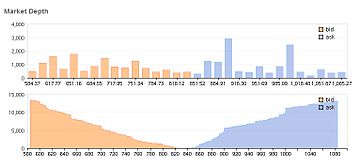The foreign exchange market has many different characteristics that help to assess its condition and opportunities, one of these indicators is the “Market Depth”.
Market depth is an assessment of the volume of transactions in a particular market, the conduct of which does not cause a change in prices. That is, it is already present supply or demand, for which you can make a deal at the current price.
If we apply this concept to the commodity market, then the assessment of the indicator will look like this:
There are ten proposals for the sale of ferrous metal on the exchange, if you enter into a contract for the supply of 100 tons with one of the suppliers, then such a step will not cause price changes. In the same case, if you want to buy 1 million tons, your demand cannot be met by one supplier, and as soon as you start making deals, the price of ferrous metal will start to rise. So it is precisely the limiting volume of purchases in this case that will be the depth of the market.
If we turn to the stock market, then everything is still quite simple, if you buy or sell all a couple of lots of shares, then such a move will not cause much excitement in the stock market. But if you decide to acquire a controlling stake, which is distributed among a large number of investors, then after the second or third transaction, the price will certainly begin to grow. This also applies to the sale, the first few lots will go at the current price, and then the rate will start to fall.
On the foreign exchange market, the depth of the market characterizes the volume of transactions that will not cause a change in the exchange rate of a particular monetary unit.
In fact, in this case, the value of supply or demand also plays a leading role, the larger the supply, the more you can buy currencies without changing the current rate and vice versa.
It is the market depth indicator that is used to conduct large-scale speculative operations, first it is estimated how many assets need to be offered to maximize the price reduction, and after this operation, depreciated goods are bought up.

